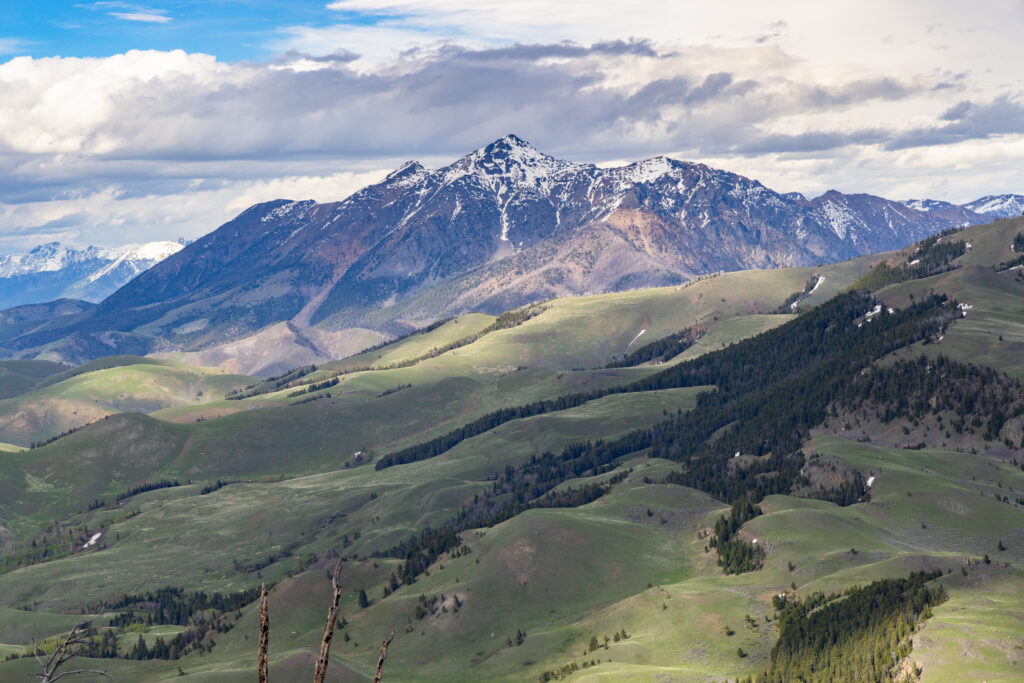Emigrant Peak in the Custer-Gallatin National Forest (Photo by Jacob Frank | National Park Service | Flickr).
Our beloved Greater Yellowstone region, with its mosaic of spectacular national parks and forests, wildlife refuges, tribal, state and private lands, is without doubt one of the planet’s great wildland ecosystems. It harbors a world class array of wildlife including every species observed by Lewis and Clark – many still in abundance. But increasingly Greater Yellowstone is besieged by an array of development threats ranging from rapid growth and rural sprawl, an ever-increasing crush of outdoor recreationists, and the growing impacts of climate change. Indeed, its long-term ecological well-being is by no means guaranteed.
Threats to Greater Yellowstone are nothing new. Forty years ago, an alarming increase in public land development such as logging, mining, and oil and gas extraction, coupled with a realization that the region’s array of public and private lands are, in fact, one grand interconnected ecosystem, inspired the creation of the Greater Yellowstone Coalition. From day one, GYC advocated and fought for a more ecological approach to protecting our stunning wildlands and wildlife. Through its education and outreach, grassroots organizing, policy reform, and litigation, GYC successfully brought to a halt many habitat damaging developments, while proactively adding new protections to public lands such as the consolidation of the Gallatin Range which had been a checkerboard of public and private ownership.
As former GYC staff and board, we are proud of these conservation achievements. They were not easy to accomplish, and in many cases, they were controversial. But once completed, they were almost always hailed as conservation victories that benefitted both wildlife as well as people, especially the communities surrounding this wild landscape.
It has become clear that maintaining the ecological integrity of our wildlife heritage requires eternal vigilance, bold thinking, and fearlessness in the face of opposition. It also requires a recognition of the intrinsic values of wildlife and wild places, regardless of whether we are directly utilizing these natural resources. And it requires an acknowledgement of the rapidly growing impacts that climate change imposes on the ecological integrity of our wildlands. Do we really want to add even more stress to these rare and special places?
The current debate over the future of the Gallatin Range is a case in point. If the Gallatin Range was in any other region of the country, it might well be considered for national park status. It harbors virtually all Greater Yellowstone’s iconic wildlife species. Equally important, it forms a critical linkage between Greater Yellowstone and wildland regions to the north, like the Crown of the Continent/Glacier Ecosystem.
Currently much of this range is protected by Wilderness Study Areas – more than 155,000 acres – which should be managed essentially as Designated Wilderness and protected from resource damaging activities such as mining and logging, as well as recreation related impacts from mechanized vehicles. In this era of climate change, Wilderness designation offers the best possibility of buffering the impacts of this existential threat.
That is why we are alarmed that GYC is now spearheading efforts to weaken these protections through their Gallatin Forest Partnership Project and the resultant Greater Yellowstone Conservation and Recreation Act. This initiative, undertaken with several special interests, carves the Gallatin Range into various management units, that while reflective of the recreational pursuits of partnership members, does not reflect the ecological needs of wildlife and the habitats upon which they depend.
It appears that GYC and the other involved organizations are unwilling to advocate for needed restrictions on individual uses of the Gallatin Range. They seem to be more concerned with coming to an agreement on “who gets what” regarding the future management of the area, than maintaining the long-term health of the ecosystem. It is a betrayal of the group’s original goals that we supported and which often required conservation actions that while not always popular, ultimately were exactly what was needed to achieve the organizations original conservation mission.
We, the undersigned, strongly urge the Greater Yellowstone Coalition to rethink their approach to protecting the incredible wildlife and wildland legacy of the Gallatin Range, and craft a new strategy that puts ecological integrity, not the special interests of user groups, at the forefront of conservation efforts. And we know that many others share this concern.
This will not be easy. But like countless past conservation actions – many of which were contentious including the very creation of Yellowstone and Grand Teton Parks – with the passage of time these controversies will be forgotten. And, those who had the courage to advocate what was needed have become heroes. GYC has shared in this legacy. Whether it can continue to celebrate its critical role in keeping Greater Yellowstone great, remains to be seen.

